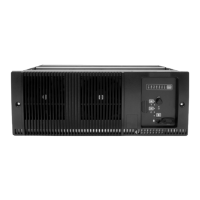124 Technical Description TB9100/P25 CG/P25 TAG Installation and Operation Manual
© Tait Limited March 2014
Power Foldback
If the temperature in the driver, Final 1 or Final 2 output stage has exceeded
the user-configurable threshold, an alarm is raised and operation continues
as normal.
If a PA temperature continues to rise and exceeds its built-in threshold
(185°F/85°C for the driver or 203°F/95°C for the final stage), the PA folds
back its power output to 10% of the configured power level (for example, a
50W PA would produce 5W).
When the temperature returns to normal (hysteresis is 9°F/5°C), the alarm
clears. To see the actual temperatures, select Diagnose > Modules > PA
Control Tests in the CSS.
Power Supply The 100W PA operates off a 28VDC external power supply only, while the
5 and 50W PAs can operate off a 28VDC or 12VDC external power supply,
depending on the model. The 12V PAs are fitted with an internal boost
regulator board (refer to “Boost Regulator” below).
The PA also has four internal power supplies located on the control board
which produce –3, +2.5, +5 and +10VDC.
Boost Regulator 5 and 50W 12V PAs are fitted with a boost regulator board. Figure 8.4 on
page 125 shows the configuration for a 50W 12V PA, along with the main
inputs and outputs for power, RF and control signals. Note that the 60W
board is only fitted to the 50W PA.
The boost regulator board accepts an input of 12VDC nominal. The input
is firstly fed through the DC input filter, and then through an output filter
and switch which is controlled by a battery control circuit. This output is
fed to the reciter, which operates from 12VDC instead of the standard
28VDC provided when a PMU is used. The output from the DC input
filter is also fed to the power stage where the voltage is boosted to 28VDC,
and is then fed through an output filter to provide the 28VDC output for
the PA circuit boards.
The battery control circuitry monitors the DC input voltage from the
battery. Protection is provided against the wrong input voltage being
supplied. Reverse polarity protection is provided by a diode between
positive and ground, and requires a user-provided fuse or circuit breaker in
series with the DC input line. The fuse or circuit breaker should be rated at
15A to 18A at 30VDC.
The minimum startup voltage is 10.8VDC ±0.25V. Once started, the boost
regulator will operate down to 10.5VDC +
0.25V before it shuts down to
prevent deep discharge of the battery.
The startup voltage and operating voltage range are set in hardware at the
factory, and cannot be adjusted in normal operation by the user. How-
ever, the startup voltage can be increased to 12VDC ±0.25V by carrying

